Luận án The effects of elevated temperature and hypoxia on the respiratory organs of Pangasianodon hypophthalmus
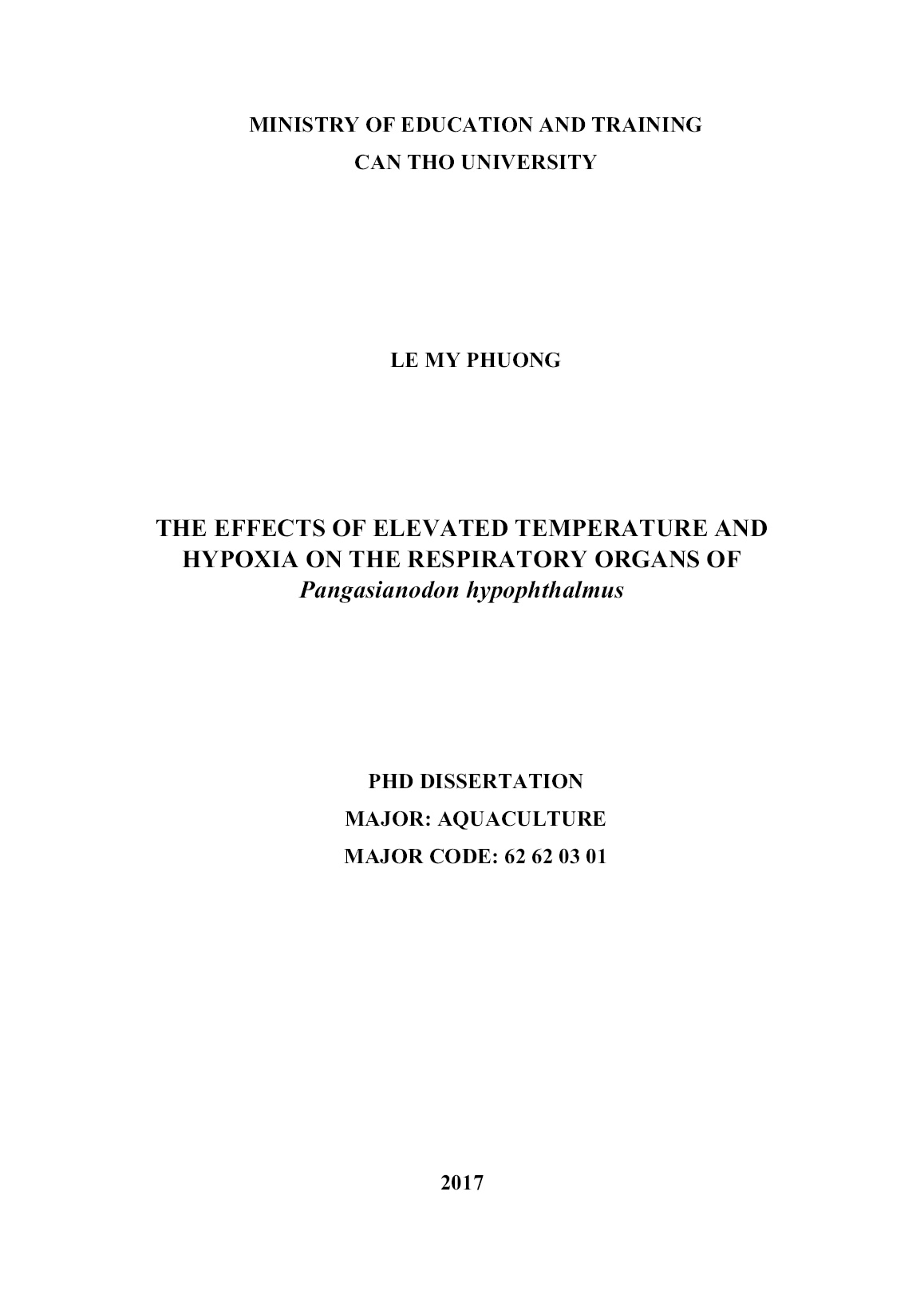
Trang 1
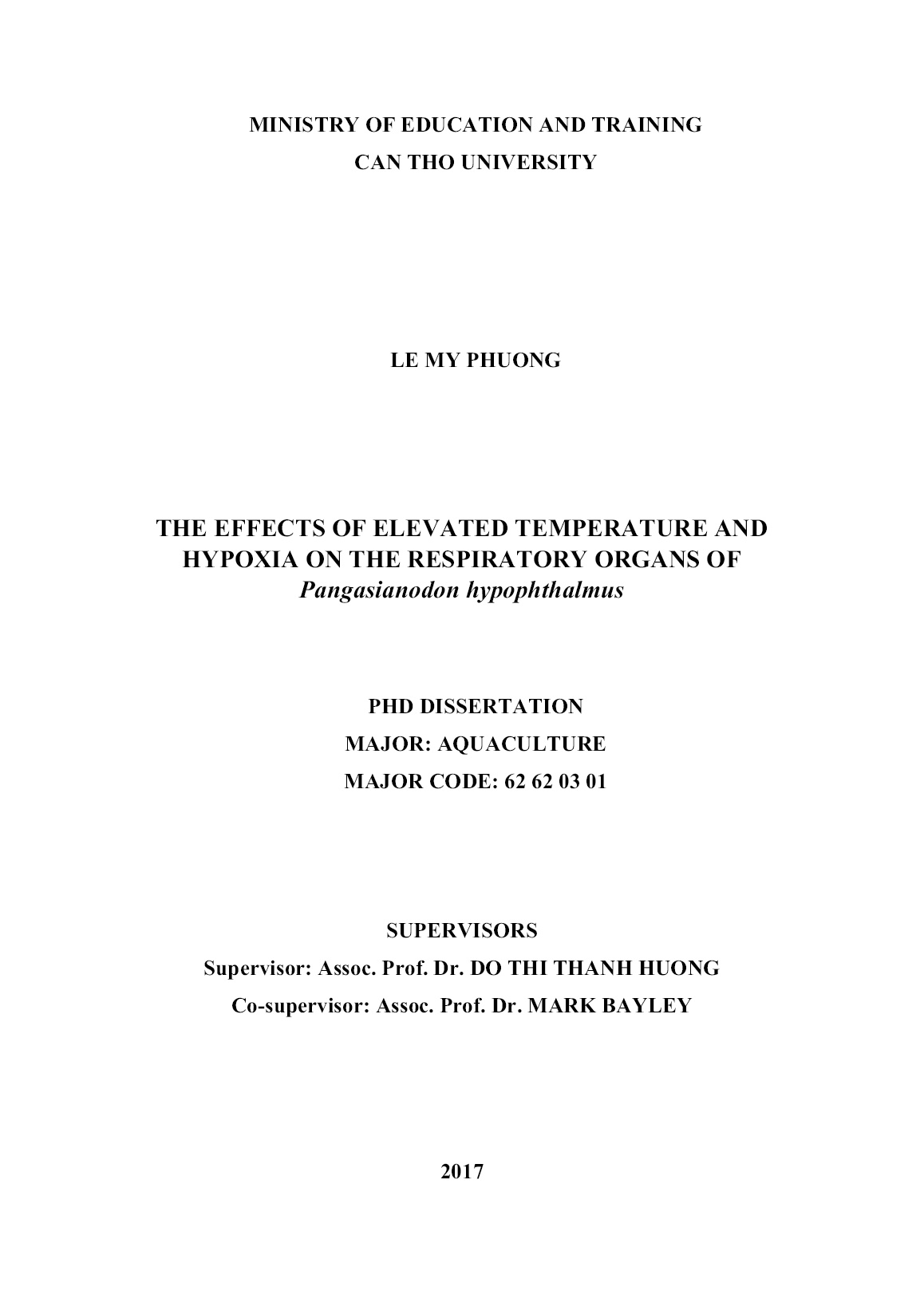
Trang 2
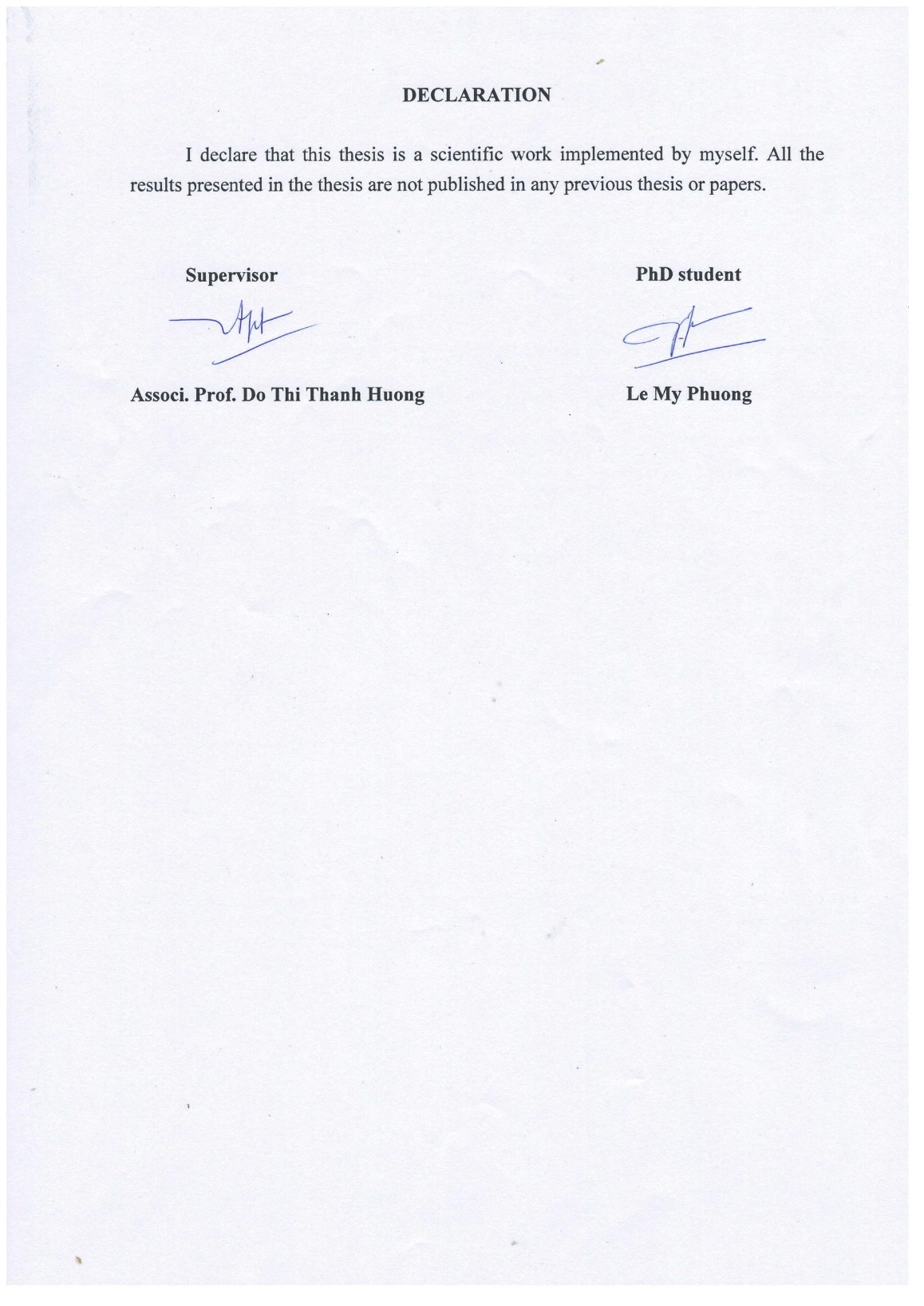
Trang 3
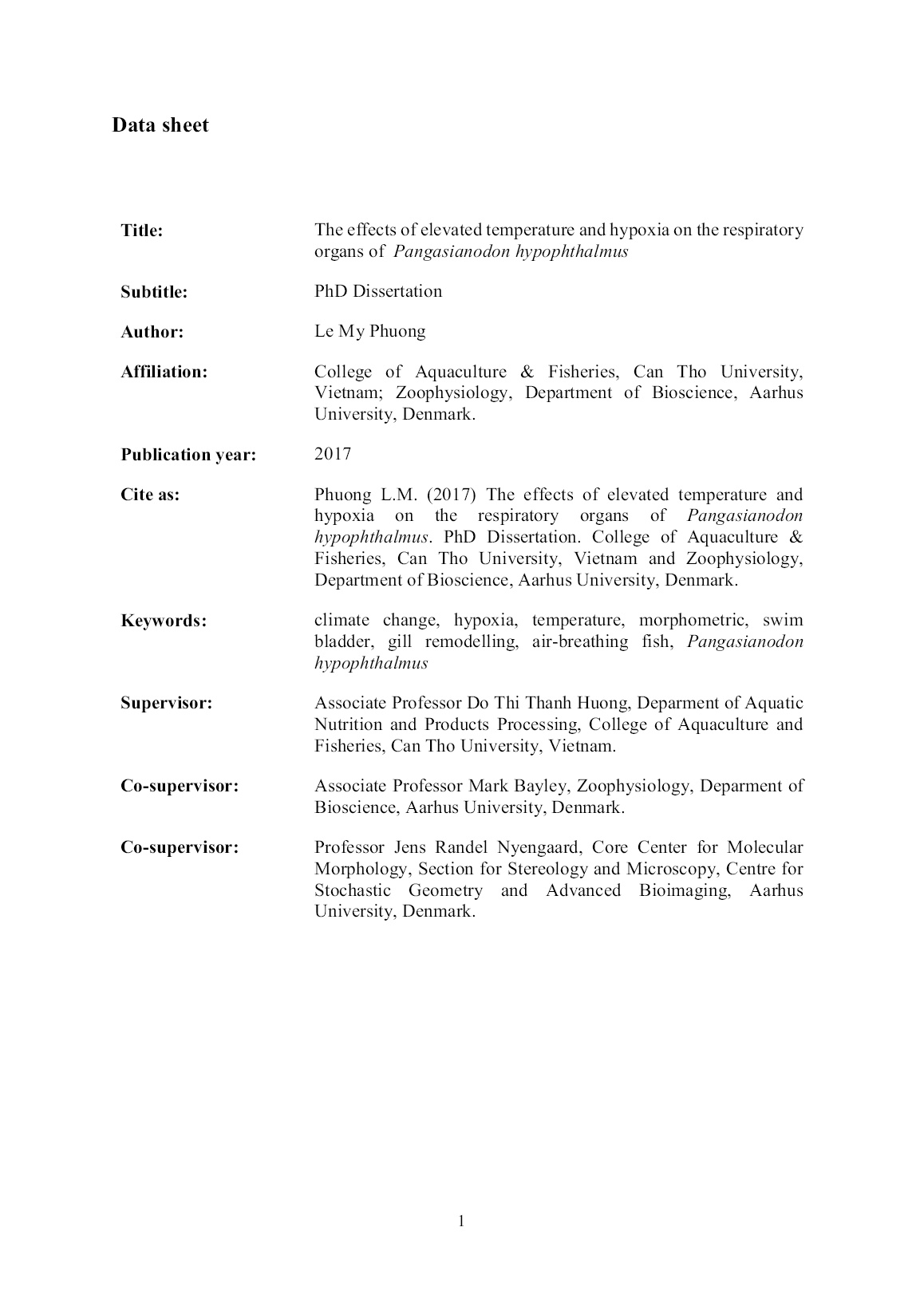
Trang 4
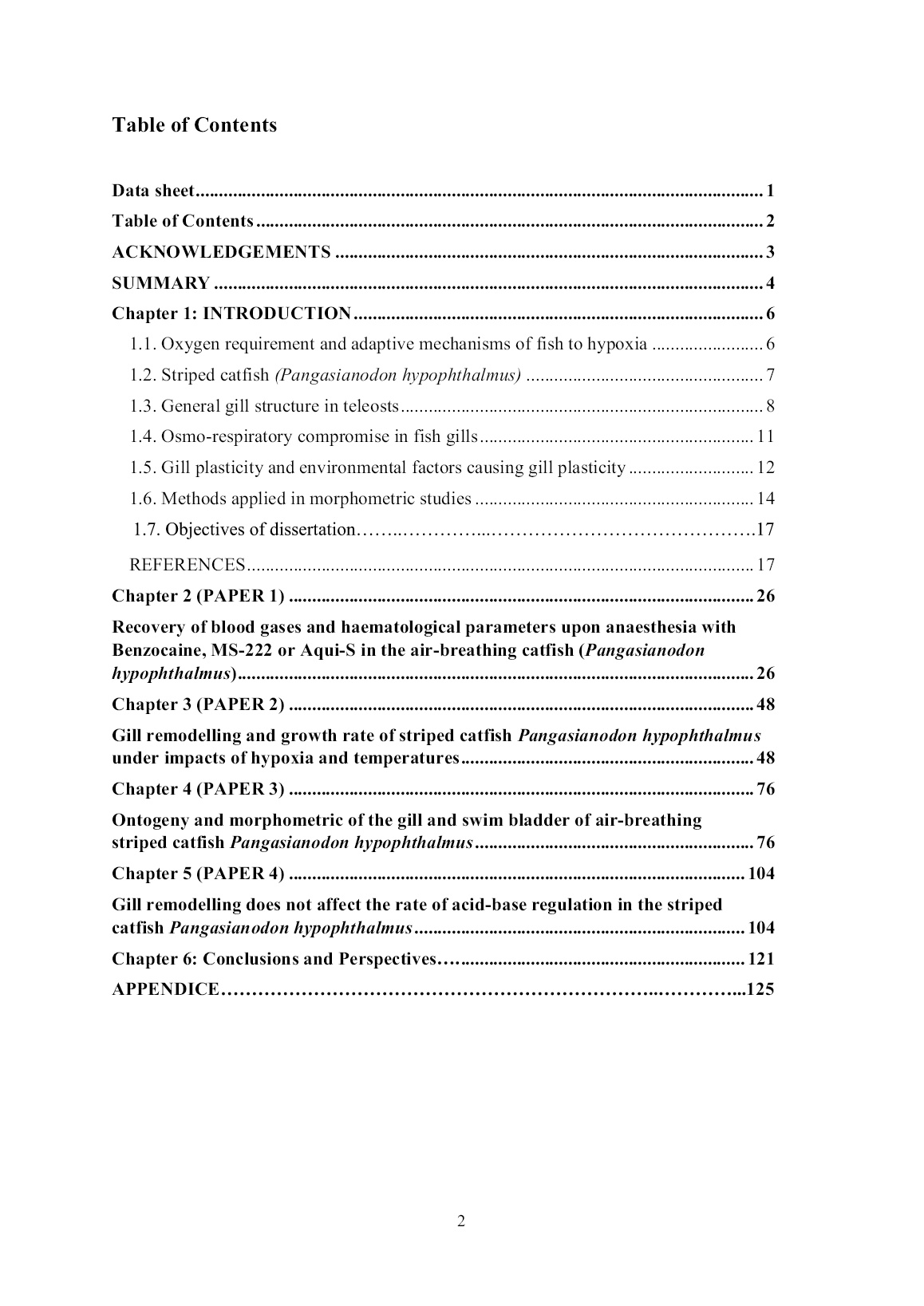
Trang 5
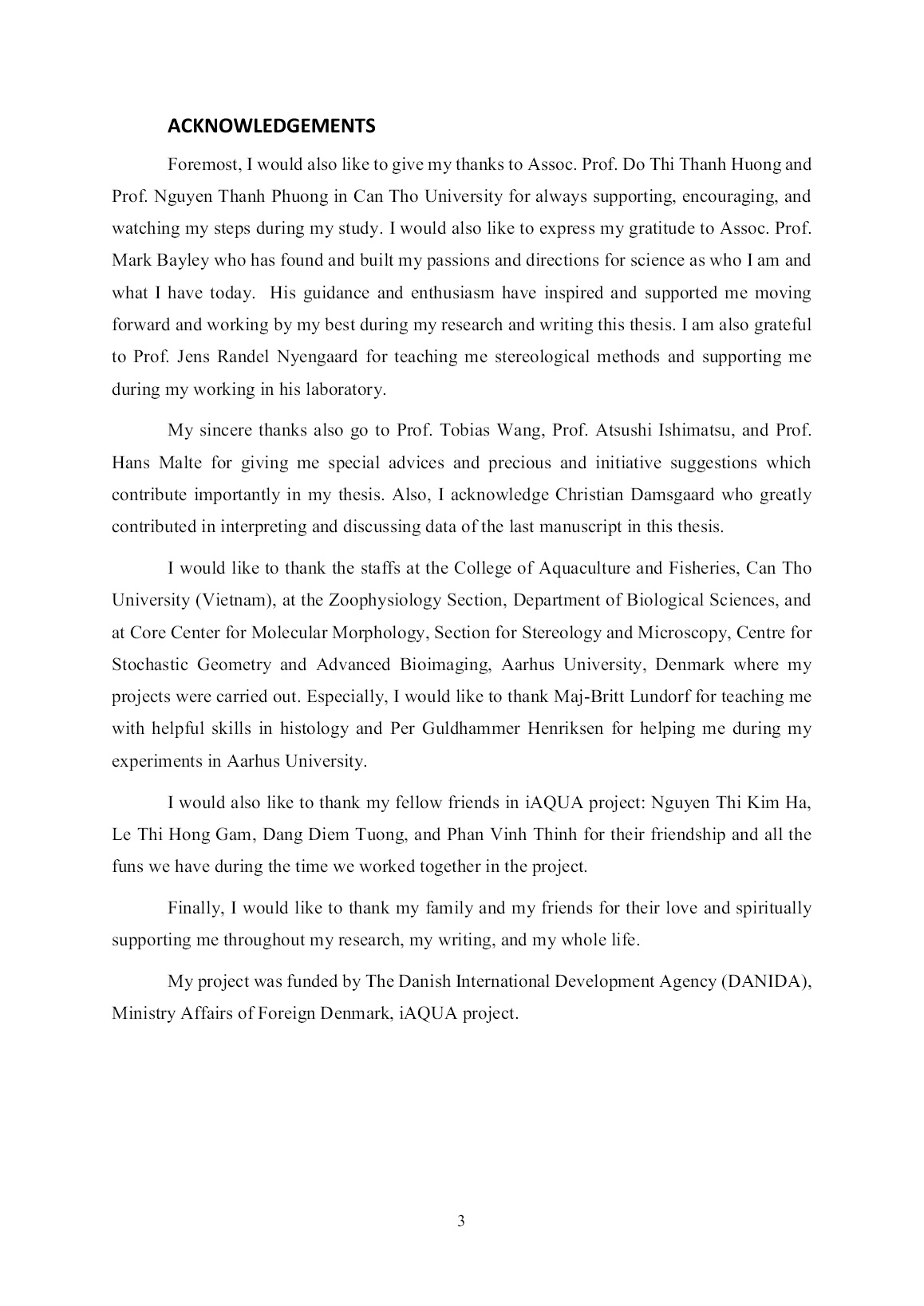
Trang 6
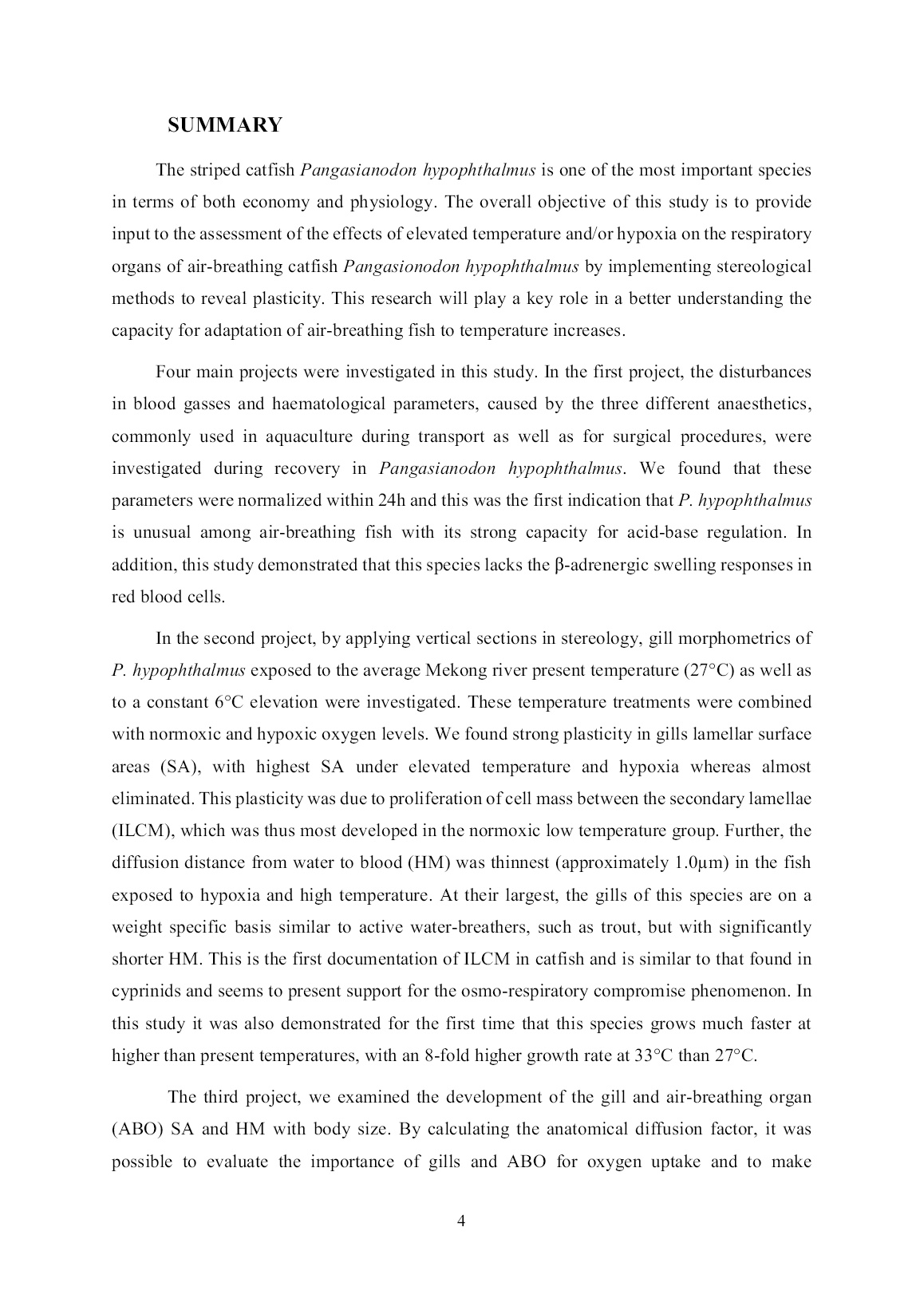
Trang 7

Trang 8
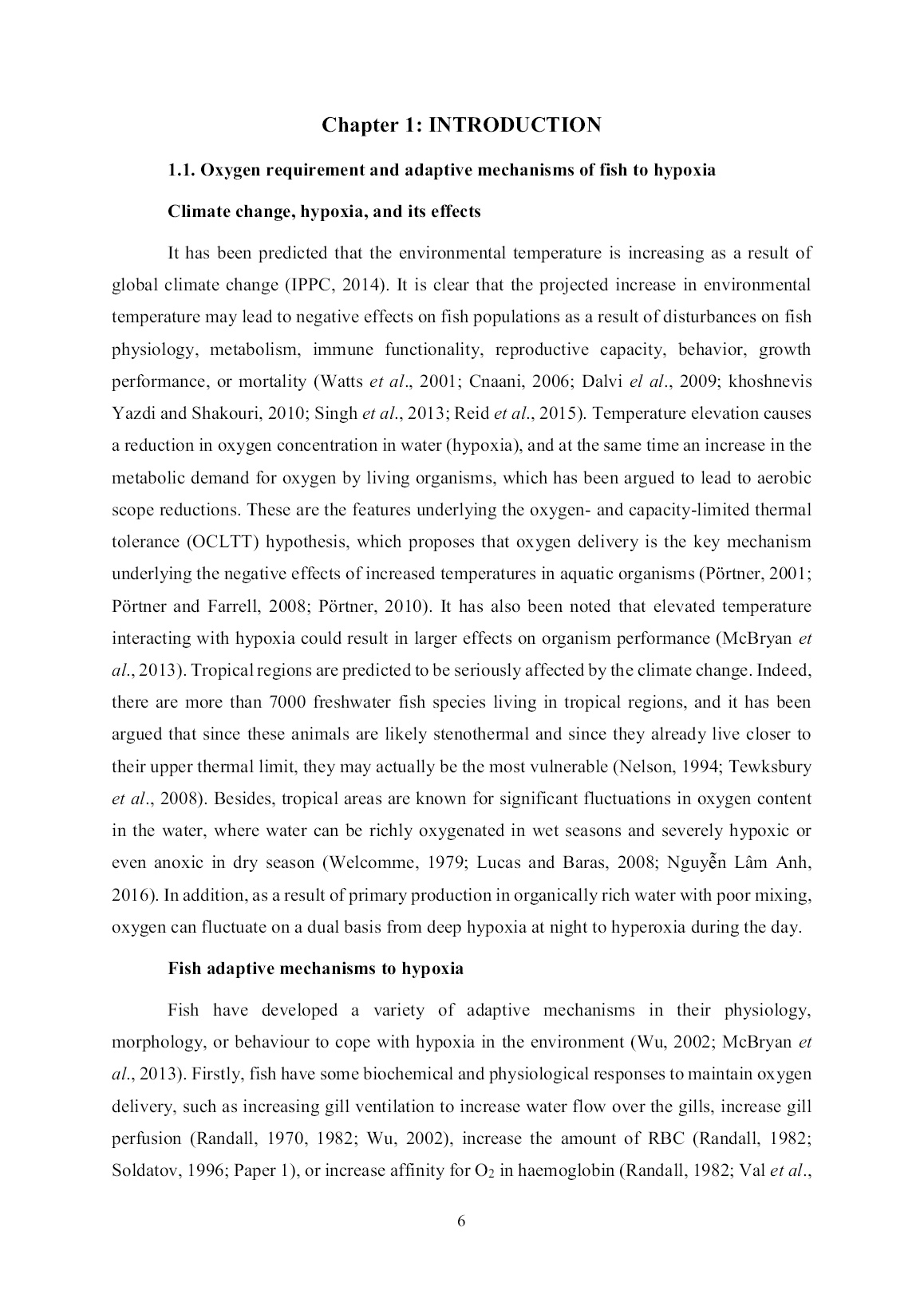
Trang 9

Trang 10
Tải về để xem bản đầy đủ
Bạn đang xem 10 trang mẫu của tài liệu "Luận án The effects of elevated temperature and hypoxia on the respiratory organs of Pangasianodon hypophthalmus", để tải tài liệu gốc về máy hãy click vào nút Download ở trên.
Tóm tắt nội dung tài liệu: Luận án The effects of elevated temperature and hypoxia on the respiratory organs of Pangasianodon hypophthalmus
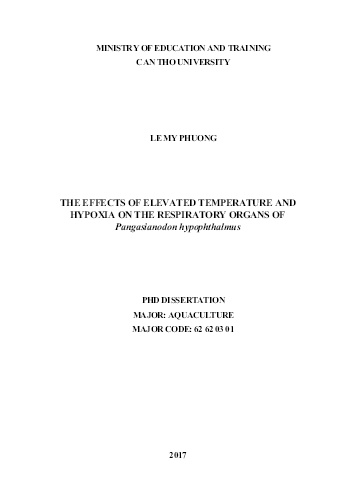
𝐹 × 𝑡̅ × ( 𝑎 𝑝 ) × ∑ 𝑃𝑒𝑝,𝑝𝑐,𝑏𝑙 VSL (mm3) = Vep + Vpc + Vbl Vparasites (mm3) = 1 𝑆𝑆𝐹 × 1 𝐴𝑆𝐹 × 𝑡̅ × ( 𝑎 𝑝 ) × ∑ 𝑃𝑝𝑎𝑟𝑎𝑠𝑖𝑡𝑒𝑠 SSF is section sampling fraction; AFS is area sampling fraction; t is section thickness; ∑PP are total number of points hitting primary filaments A/P is area per point ∑PP,ep,pc,bl are total number of points hitting primary filaments, epithelium, pillar cells, and blood spaces, respectively; a/p is area per point ∑Pparasites are total number of points hitting parasites Surface area of secondary lamella SSL SSL (mm2) = 2 × ∑ 𝐼𝑖 ( 𝑙 𝑝 )× ∑ 𝑃𝑖 × 𝑉𝑆𝐿 ∑Ii are total number of intersections between test lines and secondary lamellae; ∑Pi are total number of points hitting secondary lamellae l/p is length per point VSL is volume of secondary lamellae The precision of the Cavalieri reference volume was estimated using the coefficient of error (CE) CE (∑P) = √𝑇𝑜𝑡𝑎𝑙 𝑣𝑎𝑟𝑖𝑎𝑛𝑐𝑒 𝑜𝑓 ∑ 𝑃 ∑ 𝑃 Total variance of ∑P = Noise + VarSURS(∑area); Noise = 0.0724 × (b/√𝑎) × √𝑛 × ∑𝑃; VarSURS(∑area) = 3(𝐴−𝑁𝑜𝑖𝑠𝑒)−4𝐵+𝐶 240 ; with A=Pi×Pi; B=Pi×Pi+1; C=Pi×Pi+2 Mean CE = [(CE12+CE22+...+CEn2)/n]1/2; CV=SD/Mean Noise is the point counting error variance; b/√𝒂 is the average profile shape and, in this study, the value of 12 was used for secondary lamella shape according to the nomogram of Gundersen and Jensen (1987); n is the number of examined sections; ∑ 𝑷 is the total number of points hitting the observed tissue; VarSURS(∑area) is variance of the total surface area. CV is Coefficient of variance Specific growth rate (SGR) of individual fish SGR (%) = [(lnW2 lnW1) / t] × 100 W1 and W2 are the initial and final weight of the fish, respectively; t is time (days) between W2 and W1 Statistics Data were presented as means ± standard error of the mean (means ± S.E.M). Two-way MANCOVA (a multivariate analysis of covariance) (Ramos et al., 2012) was used in this study to test for overall effects of temperature, oxygen or parasite volume on gill parameters followed by Turkey’s post hoc test to identify differences between samples. For growth performance, two-way ANOVA was used to test whether higher temperature and/or hypoxia significantly affected on P. hypophthalmus growth performance as well as to compare means amongst treatments in each period of samplings. A probability (P) value at the 0.05 level was considered as significant. All the statistics applied in this study were performed by using PASW Statistic 18.0. 56 3.3. Results Gill morphometric Gill surface area There were significant changes in secondary lamellae surface area of the fish with time, with temperature and with hypoxia (Fig. 3.1A, B; Table 3.1; Table 3.2). At the beginning of the experiment, the respiratory surface area of small fish (12.4±0.8 g) at 27ᵒC in normoxic water was 212±22 mm2 g-1. After 5 weeks in 27ᵒC, however, the lamella surface area decreased significantly to 12.9±7.9 mm2 g-1. The addition of hypoxia in this group resulted in even smaller 4.9±2.3 mm2 g-1 although there was no significant difference between these two groups (P>0.05). In both 27ᵒC groups at 5 weeks, the gill filaments had undergone a significant change in morphology, with the inter lamellae spaces filling almost completely with a cell mass (Fig. 3.2). In contrast, fish exposed to 33ᵒC, showed surface area at 5 weeks that allometrically scaled with size in the hypoxic group (208±29 mm2 g-1) whereas in the normoxic group a reduction to 39.4±3.5 mm2 g-1 occurred (Fig. 3.1B). With long-term exposure (16 weeks) to the same conditions, the surface area of lamellae in the low temperature groups was again much lower than those in elevated temperature. Highest surface area (160±19 mm2 g-1) was found in 33ᵒC & hypoxia group, followed by 133±25 mm2 g-1 in 33ᵒC & normoxia, which was 8.0-fold and 6.5-fold, larger than the corresponding areas in the two groups at 27ᵒC (Table 3.1). 57 Fig. 3.1 Respiratory lamella surface area according to body mass of juvenile striped catfish (Pangasianodon hypophthalmus) reared in different temperatures and/or hypoxia after 5 week exposures (I) and 1 week recovery without hypoxia exposure (II). A shows respiratory lamella surface area of individual fish; B shows mean respiratory lamella surface area per fish body mass, with data being presented as mean ± S.E.M. Different letters indicate significant difference amongst treatments (P<0.05). Fig. 3.2 Light micrographs of Pangasianodon hypophthalmus gill filaments from fish in 27ᵒC and Normoxia treatment (left) and fish in 33ᵒC and Hypoxia treatment (right). Scale bar 50 µm. Fish mass (g) 0 20 40 60 80 R e s p ir a to r y l a m e ll a s u rf a c e a re a ( m m 2 ) 0 2000 4000 6000 8000 10000 12000 14000 16000 27oC & 92% (Beginning) 27oC & 92% (I) 27oC & 35% (I) 33oC & 92% (I) 33oC & 35% (I) 27oC & 92% (II) 27oC & 92%* (II) 33oC & 92% (II) 33oC & 92%* (II) Time (weeks) 0 1 2 3 4 5 6 S u rf a c e a re a /M a s s ( m m 2 g -1 ) 0 50 100 150 200 250 a a ac b b b b c A B 58 Water – blood diffusion distance The harmonic mean barrier thickness of juvenile P. hypophthalmus (12.4±0.8 g) was 1.67±0.12 µm (Table 3.1). It was almost impossible to measure respiratory diffusion distance in the groups of fish after 5 and then 6 weeks of low temperature exposure under either hypoxic or normoxic water because their lamellae were filled with ILCM (Fig. 3.2). However, in the 33ᵒC groups hypoxia caused a significant reduction in harmonic mean barrier thickness from 1.64±0.16 µm in normoxia to 1.04±0.18 µm in hypoxia (Table 3.1). Volumes of gill components Table 3.1 presents the volume of gill filaments and the percentages of secondary lamella on the filaments as well as the percentages of other components (pillar cells, blood spaces, and epithelium) constructing secondary lamella of experimental fish. The total volume of gill filaments of juvenile striped catfish P. hypophthalmus (12.4±0.8 g) was around 101.9±5.7 mm3 (with 8.38±0.37 mm3 g-1) in which secondary lamella accounted for 12.6±1.23% (1.6±0.28% pillar cells, 4.9±0.78% blood spaces, and 6.1±0.46% epithelium). The volume of gill filaments ranged around 7.3 11 mm3 g-1 fish between the groups of fish exposed to temperature and/or hypoxia. This parameter was neither significantly affected by ambient hypoxic water nor the interaction between temperature and hypoxia factors, although being affected by temperature (P<0.01) (Table 3.2). The volume of secondary lamellae which exposed to water of the fish at 27ᵒC groups decreased significantly after 5 weeks, to less than 1% of filament volume, and similar in the recovery week (without exposure to hypoxia); whereas the lamella volume was high in the high temperature group, especially with added hypoxia. At the same time, the total blood space volume of secondary lamella in this group (9.59±1.3%) significantly increased by a factor of 10 as compared to the other groups, and of 2 as compared to the beginning group; however, the epithelium volume decreased twice, with 3.59±0.41% compared to 6.1±0.46% of the beginning group. The same pattern was found for the fish exposed long-term to the conditions (after 16 weeks), which volume of lamella decreased sharply at 27ᵒC opposite to those of the high temperature groups (Table 3.1). During the experiments, parasites were found on gills of several fish, however, they did not cause significant effects on any of gill parameters observed (P>0.05) (Table 3.2). 59 Table 3.1 Lamellae respiratory surface area (mm2 g-1), harmonic mean water-blood barrier thickness (µm), volumes of gill filaments (mm3 g-1), the percentages of secondary lamellar volume and lamellae structural component volumes (pillar cells, blood spaces, epithelium) of Pangasianodon hypophthalmus exposed to elevated temperature and/or hypoxia. Data are presented as mean ± SEM. Experiments Treatments Mass (g) Lamella Surface area/mass (mm2 g-1) Harmonic mean water- blood barrier thickness, τh (µm) CV Gill Filament volume/mass (mm3 g-1) Mean CE (%) % Volume Pillar cells Mean CE (%) % Volume Blood spaces Mean CE (%) % Volume Epithelium Mean CE (%) % Absolute volume secondary lamellae exposed to water Parasites volume/mass (mm3 g-1) No. fish infected/ Total I (0 week) Beginning (n=12) 12.4 ± 0.8 212 ± 22 1.67 ± 0.12 0.26 8.4 ± 0.4 0.09 1.6 ± 0.28 0.44 4.9 ± 0.78 0.12 6.1 ± 0.46 0.07 12.6 ± 1.23 0 0/12 I (5 weeks) 27ᵒC & 92% (n=5) 24.6 ± 2.8 12.9 ± 8.0 - - 11.3 ±1.2 0.03 0.09 ± 0.05 6.8 0.26 ± 0.16 2.1 0.62 ± 0.3 1.56 0.98 ± 0.49 0.15 ± 0.01 5/5 27ᵒC & 35% (n=5) 25.6 ± 3.6 4.9 ± 2.3 - - 10.1 ± 0.6 0.03 0.04 ± 0.02 43.2 0.16 ± 0.05 7.0 0.34 ± 0.14 5.3 0.53 ± 0.18 0.12 ± 0.02 4/5 33ᵒC & 92% (n=5) 44.3 ± 5.6 39.4 ± 3.5 1.64 ± 0.16 0.22 8.6 ± 0.5 0.03 0.43 ± 0.07 0.46 1.27 ± 0.23 0.14 1.74 ± 0.33 0.08 3.44 ± 0.6 0.1 ± 0.02 4/5 33ᵒC & 35% (n=5) 47.9 ± 1.5 208 ± 29 1.04 ± 0.18 0.08 7.5 ± 0.4 0.02 1.5 ± 0.19 0.07 9.59 ± 1.3 0.01 3.59 ± 0.41 0.02 14.67 ± 1.81 0.07 ± 0.01 4/5 I (Recovery 1 week) 27ᵒC & 92% (n=5) 28.4 ± 2.4 4.3 ± 0.7 - - 10.1 ± 0.3 0.03 - - - - - - - 0.08 ± 0.02 3/5 27ᵒC & 35% (n=5) 25.9 ± 2.9 2.9 ± 1.2 - - 10.1 ± 0.9 0.03 - - - - - - - 0.1 ± 0.02 4/5 33ᵒC & 92% (n=5) 52.5 ± 5.7 53.5 ± 11.1 1.21 ± 0.07 0.14 8.3 ± 0.7 0.02 0.42 ± 0.1 0.46 2.47 ± 0.8 0.06 1.58 ± 0.33 0.07 4.46 ± 1.22 0.1 ± 0.02 4/5 33ᵒC & 35% (n=5) 54.1 ± 7.6 144 ± 18 0.86 ± 0.12 0.11 7.4 ± 0.4 0.02 0.82 ± 0.21 0.23 6.3 ± 0.8 0.02 2.51 ± 0.18 0.04 9.63 ± 1.12 0.05 ± 0.01 3/5 II (16 weeks) 27ᵒC & 92% (n=5) 27.6 ± 2.8 20 ± 4 1.17 ± 0.25 0.42 7.8 ± 0.8 0.04 0.13 ± 0.04 8.3 0.58 ± 0.12 0.56 1.36 ± 0.33 0.26 2.06 ± 0.46 0.02 1/5 27ᵒC & 35% (n=4) 22.4 ± 2 19.2 ± 16.4 - - 7.3 ± 1.4 0.06 - - - - - - - 0 0/4 33ᵒC & 92% (n=5) 204 ± 36 133 ± 25 1.13 ± 0.12 0.23 7.3 ± 0.4 0.02 0.95 ± 0.27 0.54 6.01 ± 1.6 0.07 2.36 ± 0.17 0.08 9.32 ± 1.89 0 0/5 33ᵒC & 35% (n=5) 108 ± 11 160 ± 19 0.98 ± 0.07 0.14 9.4 ± 0.8 0.02 0.87 ± 0.22 0.16 4.77 ± 1.36 0.05 2.55 ± 0.91 0.06 8.19 ± 2.41 0 0/5 60 Table 3.2 Evaluation the significant effects of temperature and/or hypoxia and parasites on growth and gill parameters of striped catfish Pangasianodon hypophthalmus Experiments Variables P-value Temperature factor O2 saturation factor Interaction of factors (Temperature * O2 saturation) Parasites (covariate) I (After 5 weeks exposure) Lamellae surface area 0.000 0.000 0.000 0.335 Filament Volume 0.004 0.127 0.937 0.566 Lamella Volume 0.000 0.000 0.000 0.357 Total Pillar cells Volume 0.000 0.002 0.001 0.445 Total Blood spaces Volume 0.000 0.000 0.000 0.590 Total epithelium volume 0.000 0.084 0.009 0.193 I (Recovery 1 week) Lamellae surface area 0.000 - - 0.158 Filament Volume 0.003 - - 0.266 Lamella Volume 0.000 - - 0.172 Total Pillar cells Volume 0.000 - - 0.191 Total Blood spaces Volume 0.000 - - 0.130 Total epithelium volume 0.000 - - 0.158 II (16 weeks) Lamellae surface area 0.000 0.540 0.427 0.640 Filament Volume 0.384 0.358 0.182 0.829 Lamella Volume 0.000 0.650 0.578 0.613 Total Pillar cells Volume 0.005 0.859 0.616 0.785 Total Blood spaces Volume 0.006 0.874 0.999 0.381 0.862 Total epithelium volume 0.260 0.829 0.333 II (Growth experiment) Growth performance 0.000 0.000 0.006 - 61 Growth performance Over the experimental period, it was found that both temperature and ambient hypoxic water caused significant effects on striped catfish growth rate (P<0.001 and P<0.01, respectively; Table 3.2). During the first 8 weeks of the experiment, some mortality (13-15%) was seen in all four treatments. However, from this time onwards, no further mortality observed. The fish in the 33ᵒC groups were clearly more active in taking feed, and the fish in these groups grew significantly faster (P<0.05) than the 27ᵒC groups (Fig. 3.3). Thus, at 16 weeks, fish in 33ᵒC had grown from 2.4±0.1 g to 165±9.8 g and 127±6.4 g in normoxia and hypoxia respectively; whereas in corresponding 27ᵒC groups, fish grew to only 26.5±1.7 g and 17.4±2.1 g. With respect to the 33ᵒC growth groups, the fish in normoxic water significantly grew faster than those in hypoxic hater (P<0.05), while there was no significant effect of water PO2 at 27ᵒC (P>0.05). Fig. 3.3 Growth performance of juvenile striped catfish (Pangasianodon hypophthalmus) reared in 33ᵒC & normoxia (white square), 33ᵒC & hypoxia (black square), 27ᵒC & normoxia (white circle), and 27ᵒC & hypoxia (black circle). Data are presented as mean ± S.E.M. Different letters indicate significant difference amongst treatments at each sampling period (P<0.05). Time (weeks) 0 2 4 6 8 10 12 14 16 F is h m a s s ( g ) 0 20 40 60 80 100 120 140 160 180 200 a a b c a a b c a a b c a a b c a a b c 62 Specific growth rate (SGR) followed the same general patterns with the additional expected fall in time declining from ca. 5% to around 2% in the high temperature groups, less than 2% for the low temperature groups (Fig. 3.4). It was evident that temperature had a particularly large effect on growth rate during the first 10 weeks with the high temperature normoxic group attaining an astounding >4% body weight gain per day, which was twice the daily rate seen in the two 27ᵒC groups. Fig. 3.4 Periodic specific growth rate (SGR) of juvenile striped catfish (Pangasianodon hypophthalmus) reared in 33ᵒC & normoxia (crossed column), 33ᵒC & hypoxia (grey column), 27ᵒC & normoxia (open column), and 27ᵒC & hypoxia (black column). Data are presented as mean ± S.E.M. 3.4. Discussion Gill morphometry and gill remodelling In the majority of fish species, the gills represent the primary organ for fish respiration but are also central in ionic and osmotic regulation, acid-base regulation, and in nitrogenous excretion (Evans et al., 2005; Diaz et al., 2009). The basic structures of the gills of P. hypophthalmus gills follow the generalised pattern in teleosts (Wilson and Laurent, 2002; Evans et al., 2005; Fernandes et al., 2012). The overall appearance is of large gill arches with Time period (weeks) 0-8 10 12 14 16 S G R ( % ) 0 1 2 3 4 5 33C & Normoxia 33C & Hypoxia 27C & Normoxia 27C & Hypoxia 63 long primary filaments resembling that of an active water breather such as rainbow trout. Although the present experiment was not designed to detect mitochondrial rich cells, visual inspection revealed that these ionophores are present on the primary lamellae in P. hypophthalmus and where present, within the ICLM, but are absent from secondary lamellae. In line with previous suggestions that this species has a large branchial surface area (Lefevre et al., 2011a, b; Lefevre et al., 2013; Damsgaard et al., 2015a) we measured a large branchial surface area in small individuals (12.4±0.8g) (27ᵒC and normoxia) and in fish grown for 5 weeks to 47.9±1.5g at 33ᵒC in hypoxia (35% saturation) to be 212±22 mm2 g-1 and 208±29 mm2 g-1, respectively (Table 3.1, Fig. 3.1). These values are indeed high compared to those of other air-breathing fish species and compare well to active water breathing species (Fig. 3.5 and refs therein). However, the second part of our hypothesis that predicted a reduction in gill SA in hypoxia to reduce the risk of oxygen loss was not supported. Thus in experiment 1, groups grown at 27ᵒC grew to a size of 20-30g over the five weeks, and developed ICLM in both normoxic and hypoxic treatments with secondary lamellae SA of 4-13 mm2g-1, with no significant effect of oxygen saturation. Those grown in 33ᵒC on the other hand grew much faster to 44-48g and also attained larger gills reaching 39 mm2g-1 in normoxia but 208 mm2g-1 in hypoxia (Table 3.1, Fig 3.1). The difference in these two groups being in the degree of ICLM proliferation (e.g. Fig 3.2). In the second experiment, which ran for 16 weeks instead of 6 the same growth stimulation was seen in relation to temperature and also the same trend for a strong temperature effect on SA. There was also a trend for higher SA in the 33ᵒC in hypoxia compared to in normoxia, but here the differences were not significant. Thus we conclude that secondary lamellae SA in P. hypophthalmus respond to increased oxygen demand by increasing SA, resulting in the highest SA in hypoxia at the highest temperature, and do not find support for reductions in SA in hypoxia. In this respect the SA plasticity we see in P. hypophthalmus resembles that of the crucian carp (Sollid et al., 2003, 2005; Sollid and Nilsson, 2006) as well as a variety of other water breathing fish (Matey et al., 2008; Tzaneva and Perry, 2010; Tzaneva et al., 2011; McBryan et al., 2016). It should be noted that when the ICLM is fully developed in this P. hypophthalmus, the apparent respiratory SA is then small even for obligate air-breathing fishes (Fig. 3.5). Nilsson (2007) argued that fish gill remodelling could be an ancient mechanism, which could be present in many other teleost species but which remains largely unexplored. It has since been shown that environmental changes can also induce gill morphology modifications in air-breathing fish. Thus the mangrove killifish remodels its gills as a result of air-exposure (Ong et al., 2007) and the dwarf gourami remodels 64 its gills as a result of water acidification (Huang and Lin, 2011). In addition to these SA differences, the harmonic mean water – blood diffusion barrier of P. hypophthalmus (1.67±0.12 µm) was thin compared to these water-breathers but was similar to the facultative air-breather Boleophthalmus boddarti (1.43 µm; Niva et al., 1981) (Fig. 3.5). Branchial surface area (mm 2 g -1 ) 0 200 400 600 800 1000 1200 1400 W a te r- b lo o d d if fu si o n d is ta n c e ( m ) 0 2 4 6 8 10 12 Dogfish Brown Bullhead Climbing perch Arapaima Arapaima Icefish Rainbow trout Stinging catfish Tench Wolf fish SnakeheadWalking catfish Striped catfish Mud Skipper Horse Mackerel Striped catfish Striped catfish Striped catfish Striped catfish Tuna Fig. 3.5 Respiratory gill surface area and harmonic mean barrier thickness of several fish species with different life-styles and habitats. Icefish, Chaenocephalus aceratus (Hughes, 1972); Rainbow trout, Oncorhynchus mykiss (Hughes, 1972); Tench, Tinca tinca (Hughes, 1972); Brown bullhead, Ameiurus nebulosus (Hughes, 1972); Dogfish, Scyliorhinus canicula (Hughes, 1972); Wolf fish, Hoplias malabaricus (Fernandez et al., 1994; Sakuragui et al., 2003); Climbing perch, Anabas testudineus (Hughes et al., 1973); Arapaima, Arapaima gigas (da Costa et al., 2007; Fernandez et al., 2012); Snakehead, Channa punctatus (Hakim et al., 1978); Walking catfish, Clarias mossambicus (Maina and Maloiy, 1986); Mud Skipper, Boleophthalmus boddarti (Niva et al., 1981); Stinging catfish, Heteropneustes fossilis (Hughes and Munshi, 1973); Horse mackerel, Trachurus trachurus (Hughes, 1966); Tuna, Katsuwonus pelamis (Muir and Hughes, 1969); Striped catfish, Pangasianodon hypophthalmus (Present study). Water-breathing species: opened circles; Facultative air-breathing species: semi-filled left circles; Obligate air-breathing species: black circles. Note: Five groups of striped catfish with the gills embedded by ILCM were not presented because of the lack of diffusion distan
File đính kèm:
 luan_an_the_effects_of_elevated_temperature_and_hypoxia_on_t.pdf
luan_an_the_effects_of_elevated_temperature_and_hypoxia_on_t.pdf Tóm tắt lận án - Tiếng Việt - Lê Mỹ Phương.pdf
Tóm tắt lận án - Tiếng Việt - Lê Mỹ Phương.pdf Tóm tắt luận án-Tiếng Anh - Lê Mỹ Phương.pdf
Tóm tắt luận án-Tiếng Anh - Lê Mỹ Phương.pdf Trang thông tin về luận án - Lê Mỹ Phương.docx
Trang thông tin về luận án - Lê Mỹ Phương.docx Trang thông tin về luận án - Tiếng Anh - Lê Mỹ Phương.docx
Trang thông tin về luận án - Tiếng Anh - Lê Mỹ Phương.docx

